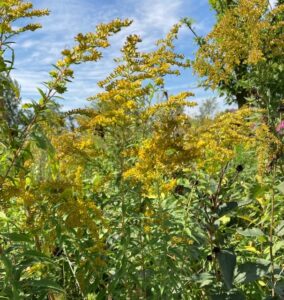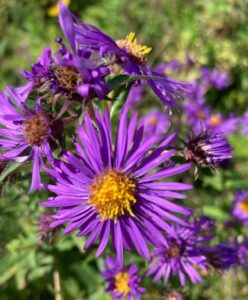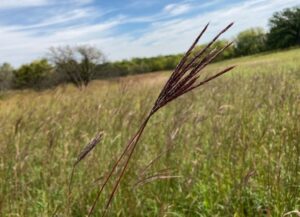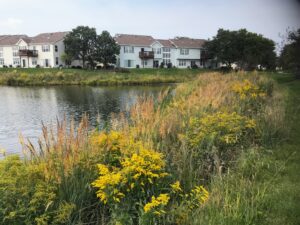By Elly Flemming (Sept. 2022)
We all feel when the change of seasons begins to turn the sharp brightness of summer into more of a dull, settled landscape. The trees start to wind down, and the blooms begin to fade. Everything seems like it is winding down for the cold months ahead. With the first chilly breeze, it is tempting to think about snowy evenings with a fleece blanket and wintery hikes through the woods. But don’t let those thoughts of winter lead you too far astray. Even though we know the crispness of summer has become stale, we can’t skip the wonderous beauty that fall brings our way—especially in the world of Illinois native plants. Sure, what we look for are the rich pinks in the Milkweed flowers or the sudden spikey white of the Rattlesnake Master hidden between the Coneflowers. Fall colors are often thought of as browns or deep reds, indicating the end of the growing season. But what about the species that have not had their chance to shine yet?
 Goldenrod waited its turn while the other yellows of the prairie dominated in the hotter summer months. So many species of Goldenrod here in Illinois contribute to the yellow sea that begins to form in late August like Ohio Goldenrod and Showy Goldenrod. These vibrant yellows differ from the fading yellow found on most trees. The tree’s color palette shows us it’s settling into rest, but the yellow on the Goldenrod indicates life and revitalization burning throughout the prairie. Another Goldenrod seen around Illinois is the Stiff Goldenrod with its lemony plumes like paintbrushes– just a burst of color at the tips. It is not quite so flashy as the Showy Goldenrod, but its color lights up the browning prairie just the same. Goldenrod in bloom is a sight to see and occurs when the thoughts of new growth have faded from our minds. So, when taking a walk to enjoy the breezy September air, appreciate the swaying stalks of yellow that waited so long to show us their beauty.
Goldenrod waited its turn while the other yellows of the prairie dominated in the hotter summer months. So many species of Goldenrod here in Illinois contribute to the yellow sea that begins to form in late August like Ohio Goldenrod and Showy Goldenrod. These vibrant yellows differ from the fading yellow found on most trees. The tree’s color palette shows us it’s settling into rest, but the yellow on the Goldenrod indicates life and revitalization burning throughout the prairie. Another Goldenrod seen around Illinois is the Stiff Goldenrod with its lemony plumes like paintbrushes– just a burst of color at the tips. It is not quite so flashy as the Showy Goldenrod, but its color lights up the browning prairie just the same. Goldenrod in bloom is a sight to see and occurs when the thoughts of new growth have faded from our minds. So, when taking a walk to enjoy the breezy September air, appreciate the swaying stalks of yellow that waited so long to show us their beauty.
 But while wandering through the fall prairie, there is another plant that may catch one’s eye. There, hidden between the flushes of amber, a stark contrast of rich purple that not many would expect to see this late in the season reveals itself. First, there is one; then, many shades of brilliant purples and light pinks reveal themselves. This is the beauty of Asters. Tall magenta clumps of New England Aster mingle with its paler counterpart Drummond’s Aster. The purple hues break up the sea of yellow in a fashion that an artist might envy to replicate. Aside from the opulent purples, there are now other white splotches in the prairie that are no longer Rattlesnake Master; Instead, striking splashes of Heath Aster and Side Flowering Aster show up in their stead. Asters and Goldenrods ignite the sleepy prairie into a new cycle of life and color.
But while wandering through the fall prairie, there is another plant that may catch one’s eye. There, hidden between the flushes of amber, a stark contrast of rich purple that not many would expect to see this late in the season reveals itself. First, there is one; then, many shades of brilliant purples and light pinks reveal themselves. This is the beauty of Asters. Tall magenta clumps of New England Aster mingle with its paler counterpart Drummond’s Aster. The purple hues break up the sea of yellow in a fashion that an artist might envy to replicate. Aside from the opulent purples, there are now other white splotches in the prairie that are no longer Rattlesnake Master; Instead, striking splashes of Heath Aster and Side Flowering Aster show up in their stead. Asters and Goldenrods ignite the sleepy prairie into a new cycle of life and color.
 Finally, this walk in the prairie is incomplete without taking the time to acknowledge the grasses that sway in the sunlight during this time of year. These individuals have also spent all summer preparing to express themselves, and now they contribute to this new life cycle of the prairie dramatically. By taking their time, they are now taller than most people walking the prairie— enveloping anyone in their presence. Big Bluestem creates texture with its Turkey foot plumes, and the fringed tufts of Indian grass shoot upwards, breaking up the blue sky with coppery flecks. These grasses are not only stunning but also are essential to the health of the prairie.
Finally, this walk in the prairie is incomplete without taking the time to acknowledge the grasses that sway in the sunlight during this time of year. These individuals have also spent all summer preparing to express themselves, and now they contribute to this new life cycle of the prairie dramatically. By taking their time, they are now taller than most people walking the prairie— enveloping anyone in their presence. Big Bluestem creates texture with its Turkey foot plumes, and the fringed tufts of Indian grass shoot upwards, breaking up the blue sky with coppery flecks. These grasses are not only stunning but also are essential to the health of the prairie.
Not only do they provide us with luxurious colors, but prairies also provide water filtration, flood management, and natural spaces for us to reflect and enjoy. As you appreciate the beautiful Fall on the prairie, also take a moment to reflect on our responsibility to the land. As we shift into the season of gratitude, remember that prairies provide for us, so we should provide for them. We have the crucial task of keeping these prairies healthy, and today many invasive species like Buckthorn and Teasel threaten their integrity. By maintaining natural areas, we protect them from the onslaught of invasive species. So next time you take a walk in the prairie, take the time to appreciate the colorful native species and ask yourself what you can do regarding your land stewardship.
This post was written with inspiration from a local prairie and an appreciation for author Robin Wall Kimmerer and her breathtaking book Braiding Sweetgrass.

